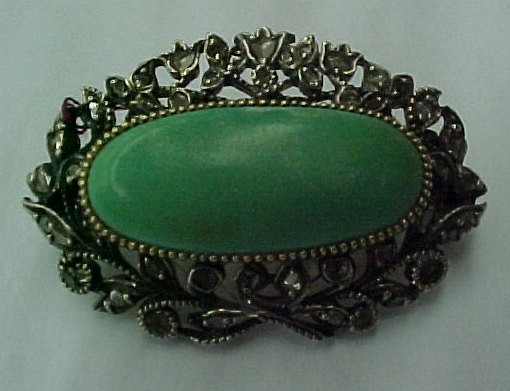
|

|

|
This is a beautiful example of a
Classical themed cameo c. 1870s. Set in buttery yellow 18K gold
(tested, no mark). Has safety clasp w/ blue stone. Convertible, 2.75
inches. Possibly Diana (note crescent moon) and maybe Persephone- looks
like she's crowned w/ pomegranates. $5000, space 83.
|

|

|

|
This
lovely cuff bracelet is solid 14K gold, tested not marked, c.1860-1870.
Three cabochon garnets, one surrounded with seed pearls. Hinged. Priced
at $2500, space 178.
|

|

|

|
While
I believe this ring is most likely c.1920s-1930s, this style (now known
as "bypass") was one of the most popular wedding ring styles of the
Victorian era. The two stones in one ring represented the union of two
people becoming one- diamonds were atypical, usually it would be the
birthstones of the bride and groom. This ring features a half carat
total of Old European Cut diamonds, my guesstimate is they're K/L
color. Clarity is not bad, they look clean and sparkly to the eye. Size
6 approximately. $1000, sp 83.
|

|

|
These
earrings are gold filled, with seed pearls and garnets. Decorated with
black enamel as well. Arrow motif, which as best I can gather was
likely a symbol of love. Most likely these were mourning, as black
enamel and garnets were typical of mourning jewelry, and seed pearls
symbolized tears. These have French wires for pierced ears, possibly a
later addition. Priced at $395, sp 178.
|
|

|

|

|
Pretty
15K gold bracelet marked Birmingham. Small gypsy set diamond. Has
safety chain. $395 space 178.
|

|

|

|
2.5
inch cameo of the three Graces. probably c.1910. Detailed 14K white
gold filigree setting, with butterfly at top and bottom. Convertible.
$950, space 83.
|

|

|
Queen
Victoria loved Scotland and things Scottish, creating a fad for jewelry
from Scotland and Scottish themes. Agate jewelry ("pebble jewelry")
were common Scottish souvenirs. This 1870s Scottish manufacture
striated grey agate brooch is shaped like a claymore sword and is hand
engraved on the sterling. Space 20.
|
|

|

|

|
This
3 inch cameo is probably from the '40s or '50s (note the smaller
upturned nose). Has new style safety clasp. The carving is exquisite-
there are grape vines twined in her hair. Set in 14K gold, marked.
Priced at $1650, space 83.
|

|

|
Another
Scottish souvenir pin. This is shaped like a dirk, setting is 9K gold.
Yellow stone is citrine, red is agate, green is bloodstone. Has a
safety chain. Priced at $260, space 20.
|
|

|

|

|
These
are coral cameos set into screw-back earrings. Seed pearl accents.
Solid 14K gold. Note the beautiful wire-work on these- very Victorian.
Priced at $650, space 178.
|

|

|

|
Rose
cut diamond and turquoise brooch. Probably c.1890s, though it has a new
pin back c.1918. The picture shows the turquoise pretty true to it's
greenish color. Unusual tulip motif as the setting. The border setting
color is silver (metal unknown) and the center is yellow gold (metal
unknown). Space 20.
|

|

|
Beautiful
yellow gold base with platinum top crucifix. Set with diamonds and
rubies, c.1900. Amazingly delicate millgrain work. Comes with platinum
chain. $2955 space 20.
|
|

|

|

|
This
locket c.1890 is solid sterling and the beautiful design is hand
engraved. Birmingham hallmark on back. Heavy chain. No picture inside
but one could easily be added. Space 20.
|


































